Coroners statistics 2021: England and Wales
Published 12 May 2022
1. Main Points
| Decrease in the number of deaths reported to coroners in 2021 | 195,200 deaths were reported to coroners in 2021, the lowest level since 1995[footnote 1] – down 5% (10,300) compared to 2020. |
| 33% of all registered deaths were reported to coroners in 2021 | The proportion of registered deaths in England and Wales reported to coroners is at the lowest level since 1995. |
| Deaths in state detention, up 3% in the last year | 580 deaths in state detention were reported to coroners in 2021 (up from 562 in 2020), the increase was driven by a 17% rise in deaths in prison custody. |
| Post-mortem examinations were carried out on 43% of all deaths reported in 2021 | There were 84,600 post-mortem examinations ordered by coroners in 2021, a 7% rise compared to 2020. The proportion of reported deaths requiring a post-mortem has increased by five percentage points over the same period. |
| 2% more inquests opened in 2021 | 32,800 inquests were opened in 2021, up 2% compared to 2020. |
| Inquest conclusions up 4%, the largest rise seen in accident/misadventure, suicide and unclassified conclusions | In 2021, 32,300 inquest conclusions were recorded in total, up 4% on 2020. Accident/misadventure, suicide and unclassified conclusions had the largest increases, up 2%, 8% and 24% on 2020, to 7,700, 4,800 and 8,100 inquest conclusions in 2021 respectively. |
| Average time taken to complete an inquest rose by four weeks | The estimated average time taken to process an inquest increased from 27 weeks in 2020 to 31 weeks in 2021. |
| Prevention of Future Deaths reports data collected for the first time | 440 Prevention of Future Deaths reports were issued in 2021. |
This annual publication presents statistics of deaths reported to Coroners in England and Wales in 2021. Information is provided on the number of deaths reported to coroners, post-mortem examinations and inquests held, and conclusions recorded at inquests. A map reference of Coroner areas in England and Wales is available in the supporting document published alongside this bulletin. For previous editions of this report please see: www.gov.uk/government/collections/coroners-and-burials-statistics.
2. Statistician’s comment
The proportion of deaths reported to coroners in England and Wales continues to fall. 2021 recorded the second highest number of registered deaths in England and Wales since 1995 (the highest being in 2020), largely due to the continued impact of Covid-19. However, deaths reported to Coroners, which form only a proportion of all registered deaths, decreased to their lowest level since 1995.
Coroners faced an unprecedented challenge at the height of the pandemic in 2020 with many complex inquests halted. Jury inquests resumed in 2021, as social distancing and other restrictions came to an end. Compared to 2020, there was a 79% increase in these inquests, but this still fell short of the 5-year pre-pandemic average by 14%. Coroners carried out post-mortem examinations on 43% of all cases reported to them.
4,820 suicide conclusions were returned in 2021, the highest recorded since reporting began. Although the inquests were concluded in 2021, some of the deaths may have occurred prior to 2021 and their respective inquests may have been delayed due to restrictions in the Covid-19 lockdown period.
In 2021, on average almost a third of coroner areas completed an inquest within 24 weeks of the date on which they were made aware of the death in line with Rule 8 of the Coroners (Inquests) Rules 2013. On average, the time taken to process an inquest increased by 4 weeks to 31 weeks. This is very likely to be a result, again, of the period of recovery from Covid restrictions.
3. Deaths Reported
5% decrease in the number of deaths reported to coroners in 2021
195,180 deaths were reported to coroners in 2021, the lowest level since 1995. This is a decrease of 10,258 (5%) from 2020. This is consistent with the recent historical trend.
33% of all registered deaths were reported to coroners in 2021
The percentage of all registered deaths that were reported to coroners has remained largely stable (a less than one percentage point decrease) when compared to 2020, and is the lowest level since 1995.
All deaths in England and Wales must be registered with the Registrar of Births and Deaths and statistics on all deaths are published by the Office for National Statistics (ONS). The ONS mortality statistics, based on death registrations, report the number of deaths registered in England and Wales in a particular year irrespective of whether a coroner has investigated the death. The Ministry of Justice’s coroner statistics provide the number of deaths which are reported to coroners in England and Wales. Further background information is provided in Chapter 1 of the supporting guidance document.
ONS registered deaths fell by 4%[footnote 2] from 2020 to 2021. In comparison, the number of deaths reported to coroners decreased by 10,258 (5%) to 195,180, the lowest level since 1995. The proportion of registered deaths in 2021 that were reported to coroners was 33%, down less than one percentage point from 2020.
The number of registered deaths in England and Wales had been broadly increasing, from a low of 484,367 in 2011 to 541,589 in 2018. 2019, however, saw a decrease to 530,857, before rising to 607,922 in 2020 – the highest level in absolute terms, due to the Covid-19 pandemic. ONS provisional figures for 2021 show a decrease to 586,213. The number of deaths reported to coroners initially followed a similar trend, from a low of 222,371 in 2011 and then rising to a high of 241,211 in 2016. However, deaths reported to coroners over the last five years fell (there was a decrease in both deaths registered and deaths reported in 2019 and 2021), as shown in figure 1. This shows a reversal to similar broadly stable levels seen prior to 2015.
Figure 1: Registered deaths and deaths reported to coroners, England and Wales, 2011-2021 (Source: Table 2)
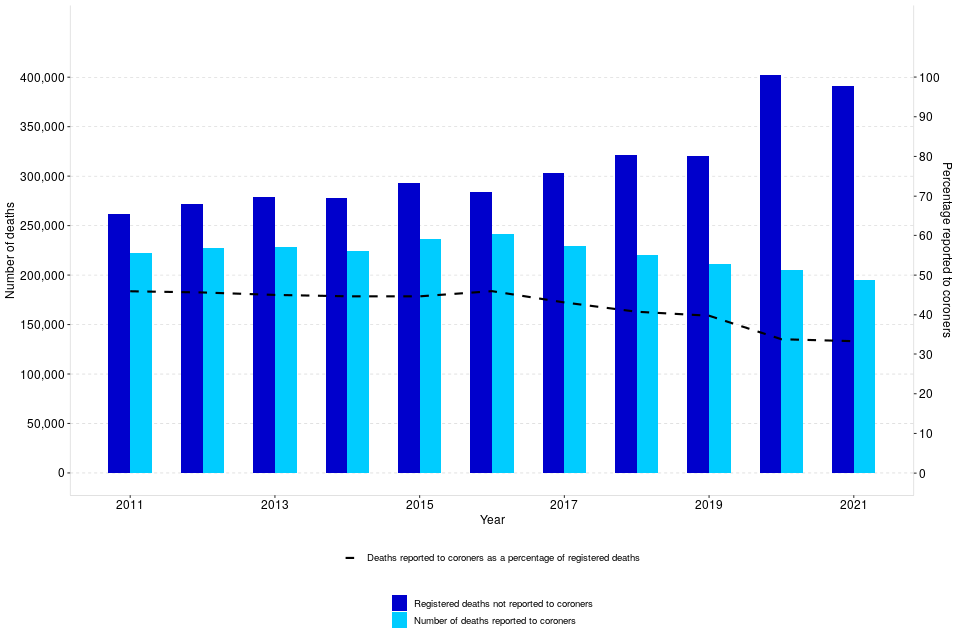
Out of England and Wales Orders
To take a body of a deceased person out of England and Wales, notice must be given to the coroner within whose area the body is lying. When the coroner gives permission for the removal of a body, an Out of England and Wales order is issued.
Coroners issued 5,751 Out of England and Wales orders in 2021, compared with 4,711 issued in 2020, and levels for 2021 returned to levels seen prior to the pandemic. In 2021, the number of orders issued represented 3% of the total number of deaths reported to coroners, showing no significant year on year trend over the past five years, (see Table 5).
Deaths abroad
Travel and tourism have been significantly impeded by the Coronavirus pandemic since it surfaced in early 2020. This has led to a significant drop in 2020 and 2021 deaths abroad where the body has been repatriated and followed by a coroner investigation. Of the 195,180 deaths reported to coroners in 2021, less than 1% (725) had occurred outside England and Wales. The lack of travel and tourism meant we saw a big drop in deaths abroad in 2020 which fell further in 2021 and is currently at 63% below pre pandemic levels.
4. Deaths in State Detention
Deaths in state detention, up 3% in the last year
Deaths in state detention reported to coroners increased by 3% to 580 in 2021, driven by a rise in number of deaths in prison custody.
In 2021, a total of 580 deaths which occurred in state detention were reported to coroners[footnote 3], an increase of 18 deaths (3%) on the previous year and representing less than 1% of all deaths reported to coroners.
There were 170 deaths of individuals subject to Mental Health Act Detention in 2021, a 22% decrease (49 cases) compared to 2020. The Care Quality Commission reported 363 deaths under the Mental Health Act 1983 (as amended)[footnote 4] in financial year 2020/21, up 51% on the number they reported in 2019/20 (240 deaths).
The number of deaths in prison custody reported to coroners increased by 17% (55 cases) compared to 2020, to 373 deaths in 2021, the highest level since reporting began in 2011. Her Majesty’s Prison and Probation Service (HMPPS) reported 371 deaths in prison custody in 2021 (Safety in Custody Statistics[footnote 5]), up 17% on the number they reported in 2020 (318 deaths). This increase was driven by deaths related to Covid-19, which peaked in 2021 Q1. The deaths in prison custody reported by coroners (373) have been cross-referenced to deaths in prison custody recorded on the HMPPS database (371) in order to ensure consistency between these two sources. The difference is due to timing. Deaths which occur close to the end of the calendar year may be reported to the coroner in the next year causing minor discrepancies. Police custody cases increased by 10, to 18 deaths. For more detailed information on prison custody deaths please see the Safety in Custody Statistics publication.
Figure 2: Number of deaths in state detention (excluding DoLS), by type of detention, 2011-2021 (Source: Table 6)
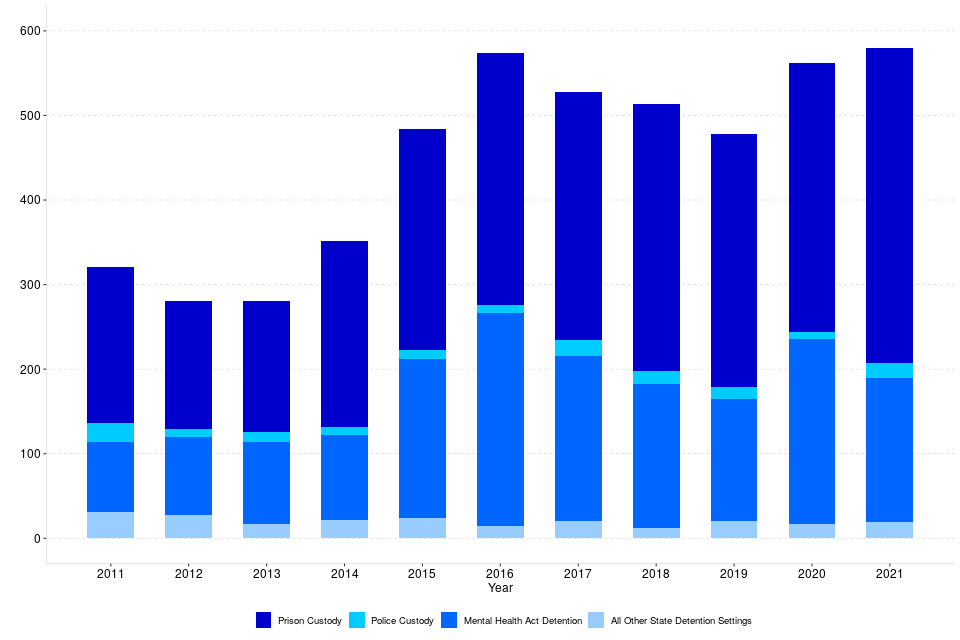
5. Post-Mortem examinations held
Post-mortem examinations were carried out in 43% of all deaths reported to coroners in 2021
There were 84,599 post-mortem examinations ordered by coroners in 2021, 43% of all cases reported to them (an increase of five percentage points since 2020).
Post-mortem examinations were held in 84,599 deaths reported to coroners in 2021, up 5,242 (7%) from 2020. This represents 43% of all deaths reported to coroners in 2021, an increase in proportion by five percentage points on the 2020 amount and the highest since 2010.
Figure 1 of the supporting guidance document published alongside these statistics provides an overview of the possible outcomes when a death is reported to a coroner, including circumstances involving a post-mortem.
Figure 3: Post-Mortems as a percentage of deaths reported to coroners, England and Wales, 2015-2021 (Source: Tables 3-4)

Post-mortem examinations may be classed as either standard or non-standard, depending on the nature of the examination. A non-standard post-mortem requires specialist skills. A non-standard post-mortem could, for example, require a paediatric or other specialist pathologist. In 2021, almost all (94%) of post-mortems were ordered at a standard rate – no change compared to 2020.
The proportion of post-mortems carried out varies across coroner areas, from 16% of deaths reported in Staffordshire South to 66% in Surrey, as shown by Map 1.
Map 1: Post-Mortem Examinations held as a proportion of deaths reported to coroners, England and Wales, 2021
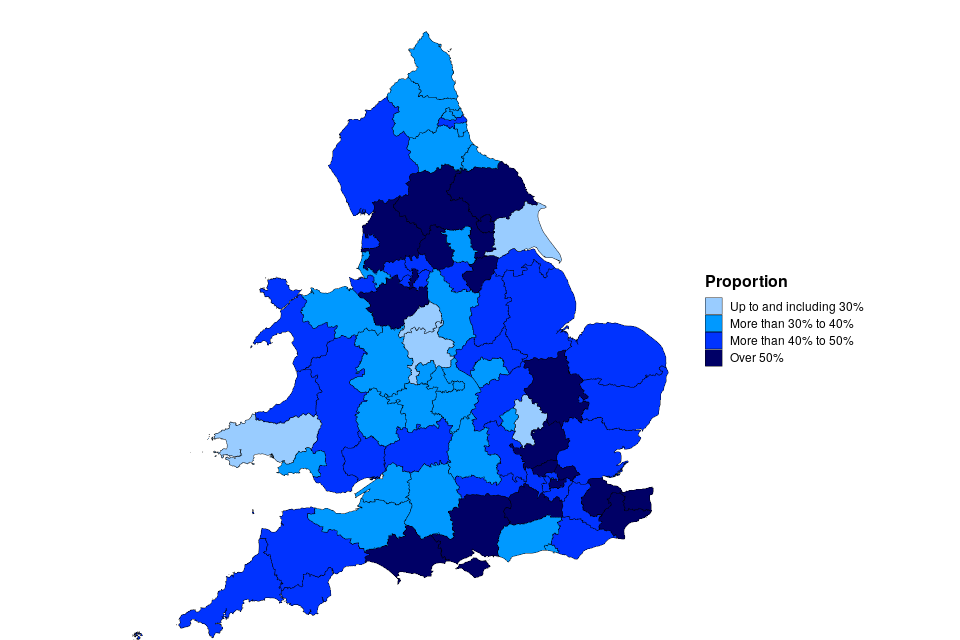
Post-mortem examinations in inquest cases
A post-mortem examination will often be held before the coroner decides whether to open an inquest. In 2021, 55% of deaths reported to coroners which eventually led to an inquest involved a post-mortem, no change on 2020.
Post-mortem examinations in non-inquest cases
In the majority (79%) of deaths referred to coroners, there is no inquest. In 2021, there were 60,084 reported deaths which did not lead to an inquest where a post-mortem was held. The percentage of non-inquest cases that required a post-mortem has seen an increase from 34% in 2020 to 39% in 2021. This figure had previously remained fairly stable since 2017.
Post-mortem examinations in potential inquest cases
Prior to July 2013 when the Coroners and Justice Act 2009 was implemented, deaths were either categorised as ‘inquest’ or ‘non-inquest’ cases. Changes in the way coroners investigate mean that there is now a third category of ‘potential inquest’ cases. This means that the coroner has opened an investigation into the death but has not yet decided whether it is necessary to hold an inquest. Depending on whether the coroner deems it necessary to hold an inquest, these cases will all eventually end up in either the ‘inquest’ or ‘non-inquest’ category. In 2021, there were 8,330 potential inquest cases being dealt with by coroners in England and Wales, with 79% requiring a post-mortem. The number of potential inquests in total has increased by 14% in the past year.
Cases requiring neither a post-mortem nor inquest
There were 94,004 deaths reported to coroners where there was neither a post-mortem nor an inquest. This type of case has decreased by 14% in the current year and the number of cases reported is the lowest level since 2000. This continues the decreasing trend seen since 2017. The proportion of all deaths reported where there was neither an inquest nor a post-mortem examination has decreased by five percentage points to 48% in 2021. This proportion has been declining since 2018.
Histology, toxicology and less-invasive post-mortems
In 2021, 23% (19,140) of all post-mortems included histology, an increase from 21% (17,002) in 2020. Post-mortems including toxicology increased by 1,331 cases over the same period to 21,133 (up 7%), with 25% of all post-mortems held in 2021 including toxicology - continuing the consistently rising trend.
There were 9,150 post-mortems conducted using less-invasive techniques and 6,255 using only less-invasive techniques (such as Computerised Tomography [CT] scans)[footnote 6] in 2021. The number of post-mortems carried out using only less-invasive techniques varied from zero in 16 areas to 1,629 in Lancashire and Blackburn with Darwen. Lancashire and Blackburn with Darwen, Black Country, Stoke-on-Trent and North Staffordshire, and Leicester City and South Leicestershire conducted over a half (85%, 72%, 64% and 54% respectively) of all their post-mortems using only less-invasive techniques. West Yorkshire (Western), South Yorkshire (Eastern), and South Yorkshire (Western) conducted over a quarter of all their post-mortems using less-invasive techniques (31%, 29% and 26% respectively).
Additionally, 34 post-mortems were conducted following a request from a defence lawyer (less than 1% of all post-mortems) and 2% (1,880) of post-mortems in 2021 were conducted by a Home Office (HO) forensic pathologist.
6. Inquests Opened
2% increase in inquests opened in 2021
The number of inquests opened in 2021 increased by 771 (up 2%) to 32,762. In the last three years there has been an increase in the number of inquests opened despite a decrease in the number of deaths reported to coroners.
There were 32,762 inquests opened in 2021, a 2% increase on 2020. The number of inquests opened in 2018 and 2019 were mostly consistent with figures before DoLS investigation requirements (see section 4) were introduced (excluding 2014, which had 25,889). However, 2020 saw an increase to 31,991 and 2021 had the highest number of inquests opened since 1995, excluding the years when DoLS investigations were required.
Inquest cases represented 17% of all the deaths reported to coroners in 2021, (16% in 2020). The number of inquests opened as a proportion of deaths reported in 2021 varied across coroner areas, from 5% in Ceredigion to 34% in York City. However, most coroner areas held inquests for between 10% and 20% of all deaths reported (59 of the 85 coroner areas). Map 2 shows the Inquests opened as a proportion of deaths reported in 2021 for all coroner areas in England and Wales.
Inquests with juries and suspended investigations (table source: Table 9)
A jury is required by law in certain inquests, including non-natural deaths in custody or other state custody or where police forces were involved. Holding inquests with juries has been a particular issue during the pandemic due to social distancing requirements, especially for coroners whose area includes a prison (or prisons), although in 2021 these restrictions started easing. Consideration for these issues should be taken into account when making comparisons to previous non-pandemic years’ figures.
There were 428 inquests held with juries in 2021 (representing 1% of all inquests), an increase of 189 (79%) compared to 2020 and a decrease of 14% when compared to the 5-year pre-pandemic average.
In 2021, 772 investigations were suspended (and not resumed) by the coroner under Schedule 1[footnote 7] of the Coroners and Justice Act 2009 because criminal proceedings took place. Of these, 729 had an inquest open at the time of suspension, representing 2% of all inquests concluded, no change compared to 2020.
Map 2: Inquests opened as a proportion of deaths reported to coroners, England and Wales, 2021
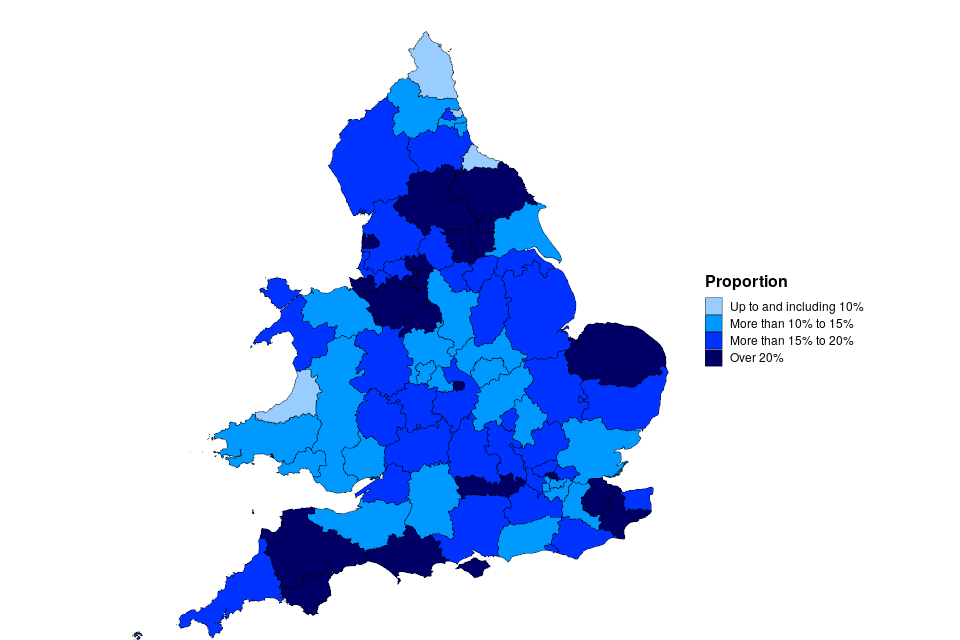
7. Inquest Conclusions
4% increase in inquest conclusions recorded, with the largest increase seen in accident/misadventure, suicide and unclassified conclusions
In 2021, 32,322 inquest conclusions were recorded, up 4% on 2020. Inquest conclusions of accident/misadventure, suicide and unclassified conclusions were up 2%, 8% and 24% on 2020 to 7,696, 4,820 and 8,126 respectively.
There were 32,322 inquest conclusions recorded in 2021, up 1,386 (4%) from 2020, in part reflecting the change in the number of inquests opened and possibly due to a backlog caused by the Covid-19 pandemic. This is the highest level since 2017. Background information on inquest conclusions is provided in Chapter 1 of the supporting guidance document.
In 2021, the most common short form conclusions (by order of frequency) were death by misadventure (7,696 or 24% of all conclusions), suicide (4,820 or 15%) and drugs and alcohol (3,890 or 12%). Unclassified conclusions (which include narrative conclusions) made up 25% (8,125) of all inquest conclusions in 2021.
A narrative conclusion is where the coroner or jury do not rely on one of the short-form conclusions and usually involves setting out the answers to the four statutory questions the coroner is required to answer in more detail.
The number of suicide conclusions increased by 8% compared to 2020, to the highest level since 1995. The increase was higher in females (16% compared to 2020) than males (which increased by 5% compared to 2020). This may be a consequence of the change in the standard of proof established by the Supreme Court in the case of Maughan.
Industrial disease conclusions fell by 20% in the last year (to 2,100 cases), falling to the lowest level since 1998.
Figure 4: Number of conclusions recorded at inquests, England and Wales, 2011-2021 (Source: Table 7)
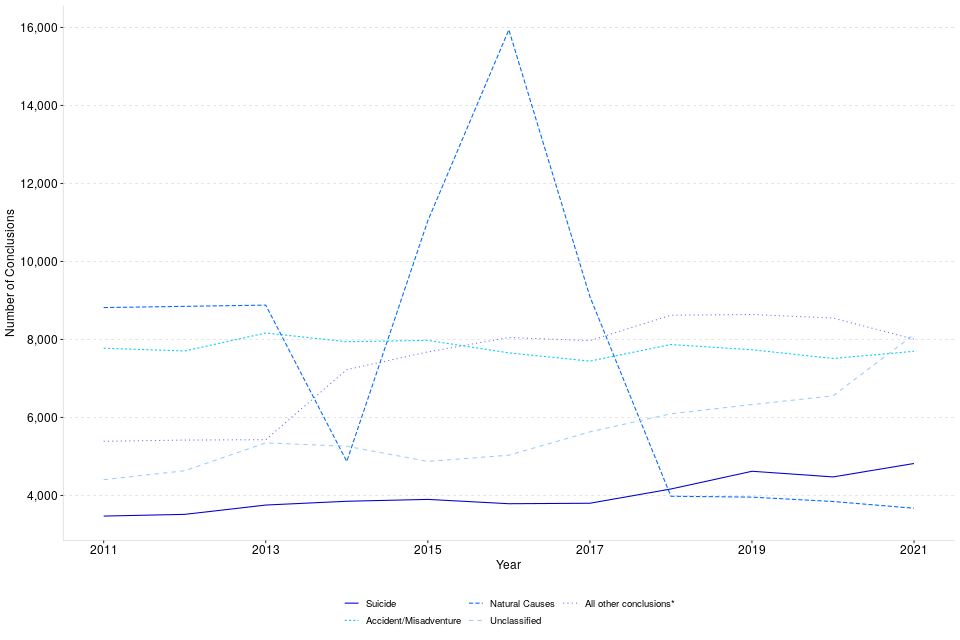
*Includes Killed unlawfully; Killed lawfully; Lack of care or self-neglect; Stillborn; Open; Industrial Disease; Drugs/Alcohol related[footnote 8]; and Road traffic collision.
In 2015 and 2016, there were significant increases in natural causes conclusions, driven by deaths of individuals subject to DoLS authorisations where the majority (94%) had an inquest conclusion of natural causes. In line with the reduction in the number of inquests opened and inquest conclusions following the removal of the requirement to report DoLS deaths, there was also a corresponding decrease in the number of natural causes conclusions in 2017 and 2018. In 2021, natural causes decreased by 4%.
In 2021, the number of unclassified conclusions increased by 1,572 cases (up 24%) to 8,125. Unclassified conclusions made up 25% of all inquest conclusions in 2021, an increase in proportion by four percentage points compared to the 2020 amount. The rise in unclassified conclusions seen until 2014 and again from 2016 is partly due to the increasing use of what are known as ‘narrative conclusions’ by some coroners. In these cases, the conclusion is recorded as unclassified. As well as narrative conclusions, this category includes short non-standard conclusions which a coroner or jury might return when the circumstances do not easily fit any of the standard conclusions[footnote 9].
The proportion of conclusions recorded as suicide has remained broadly constant over the past four years, seeing an increase from 14% of all conclusions in 2020 to 15% in 2021.
For the remaining conclusion types, alcohol/drugs related deaths have continued to increase. This year it increased by 50 cases (up 1%) to 3,890, the highest it has been since 2014. Road traffic collisions increased by 46 cases (up 6%) to 820.
Open conclusions have seen a decrease over the last decade - they accounted for 3% in 2021 compared with 7% in 2011.
Figure 5 shows the proportion changes in inquest conclusions between 2020 and 2021.
Figure 5: Conclusions recorded at inquest, by category and as a proportion of all conclusions, England and Wales, 2020 and 2021 (Source: Table 7)[footnote 10] [footnote 11]
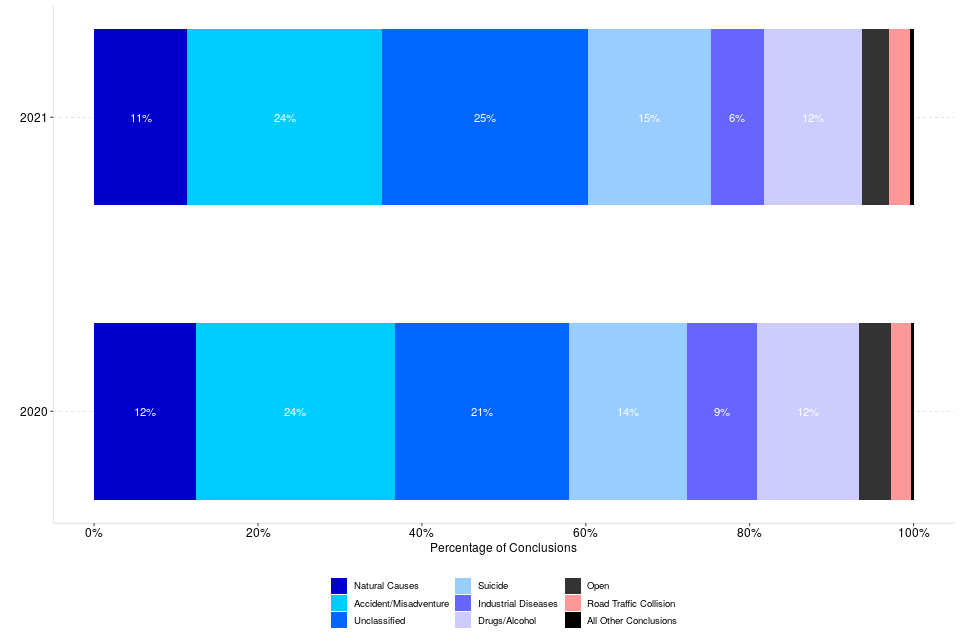
8. Inquest Conclusions by Sex
Conclusions recorded at inquests by sex[footnote 12]
Male deaths accounted for 65% of all conclusions recorded in 2021 while female deaths accounted for 35%, the same percentages as in 2020.
The pattern of conclusions recorded differs between males and females. Males accounted for 58% of deaths reported but 65% of all conclusions recorded in 2021; this suggests that males are more likely to die in circumstances that lead to an inquest.
Correspondingly, female deaths accounted for 35% of all conclusions recorded in 2021 (and 42% of all deaths reported). Figure 6 shows the variation in the sex proportions, depending on the type of inquest conclusion. Industrial disease had the highest proportion of inquests relating to males, at 91%, and accident/misadventure had the highest proportion of inquests relating to females[footnote 13], at 45%.
Figure 6: Conclusions recorded at inquests by sex, England and Wales, 2021 (Source: Table 7)

9. Inquest Conclusions by Age
The majority of inquests completed were for those aged 65 years and over
Of the inquests completed in 2021, 53% related to persons who were aged 65 years or over at time of death compared with 5% relating to persons under 25 years of age.
The profile of the age of deceased at inquests has changed slightly from 2020 to 2021. The percentage of inquests completed relating to persons aged 65 or over has decreased by two percentage points from 55% to 53%. By contrast, 5% and 41% of inquests concluded related to persons under 25 years and those between 25 and 65 years of age respectively, both up one percentage point compared to 2020 (see Table 8).
Although an age breakdown of registered deaths in England and Wales in 2021 is not yet available, ONS figures for 2020[footnote 14] show that 85% of registered deaths in England and Wales were persons aged 65 or over, with only 1% aged under 25 years old.
Figure 7: Proportion of inquest conclusions by age of deceased, England and Wales, 2020 and 2021 (Source: Table 8)[footnote 15]
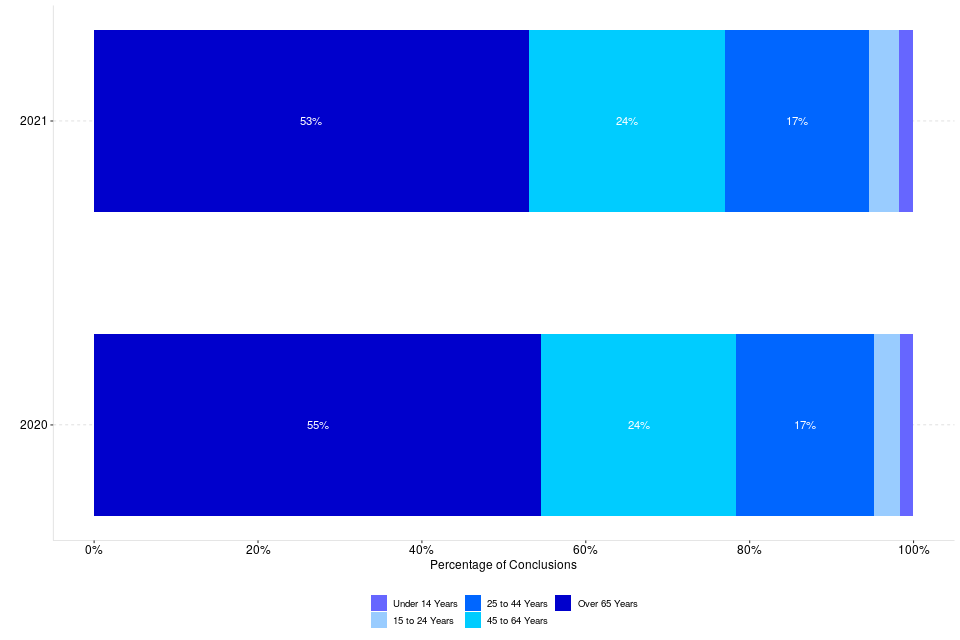
10. Time taken to process an inquest
Overall an increase of four weeks in the average time taken to process an inquest
The estimated average time taken to process an inquest is up from 27 weeks in 2020 to 31 weeks in 2021.
The estimated[footnote 16] average time taken to process an inquest in 2021 (defined as being from the date the death was reported until the conclusion of the inquest) was 31 weeks (see Table 13)[footnote 17], an increase of four weeks compared to 2020. This is likely due to a backlog of cases caused by the Covid-19 pandemic.
The decreases in time taken that occurred in 2015 and 2016 can largely be attributed to DoLS deaths where, in accordance with the Chief Coroner’s guidance, in uncontroversial cases, there could be a ‘paper inquest’, i.e. the Coroner in open court considered the evidence on the papers, which had been discussed in advance with the family (and interested persons) – this agreed process which usually did not require a post-mortem examination report took much less time to process and conclude – thus reducing the average time.
The time taken to process an inquest varies by coroner area - the maximum average time taken to process an inquest in 2021 was 75 weeks in Inner South London, and the minimum average time was 11 weeks in Liverpool and the Wirral. This disparity between regions is mainly due to differences that exist from one coroner area to another. Some of these differences are:
-
Availability of resource, staff and judicial resources
-
The presence of facilities like hospitals and prisons situated near boundary lines
-
Socio-economic make up of regions
Therefore, a direct comparison between coroner areas is not advised.
Map 3 provides an overview of average time taken across coroner areas in England and Wales.
More information about how the average time taken has been estimated can be found in the Guide to coroners statistics published alongside this report.
Figure 8: Average time taken to process an inquest (in weeks), 2009-2021 (Source: Table 9)

Map 3: Estimated average time taken to process inquests, England and Wales, 2021

11. Prevention of Future Death reports
There were 440 PFD reports issued by coroners in 2021.
The Prevention of Future Deaths (PFD) report is written by Coroners following an inquest, if it appears there are factors which represent a continuing risk of future deaths. The PFD report is issued to people or organisations to follow up on actions to reduce that risk.
In response to the Justice Committee recommendations[footnote 18], the number of PFD reports issued by Coroners has been included in these annual statistics for the first time.
There were 440 PFD reports issued in 2021. The organisations that received these include Department of Health and Social Care, NHS England and HM Prison and Probation Service.
Categories the reports covered included:
- Community healthcare
- Care Home Health related deaths
- Hospital Death (Clinical Procedures and medical management)
- Mental Health related deaths
All the coroner regions issued PFDs in 2021. The highest number issued was 86, by the North West region which also had the highest number of inquest conclusions. Wales issued the fewest reports - 16. 29 coroner areas issued no PFDs in 2021. PFD reports and the responses to them must be copied to the Chief Coroner, who may publish them on the Judiciary website. A copy of individual PFD reports can be found here.
12. Treasure and Treasure Trove
There was a 13% increase in Treasure finds[footnote 19] reported in 2021 and a 2% increase in inquest conclusions into finds
908 finds were reported to coroners in 2021, an increase of 105 on 2020. 229 inquests were concluded into finds. Of these, 97% (222) returned a verdict of treasure, a decrease in proportion by one percentage point when compared to 2020.
In 2021, 908 finds were reported and 229 inquests were concluded. There were no inquests held into Treasure Trove in 2021 (relating to finds made before the Treasure Act 1996 came into force), although it is likely that a few such inquests will continue to be held from time to time.
The number of finds reported has historically been steadily increasing since the commencement of the 1996 Act in September 1997, from 54 finds in 1997 to 1,059 in 2017. Since 2018, however, the number has been more volatile. In 2021 the number of finds rose to 908 from 803 in 2020 (up 13%), likely due to the easing of pandemic restrictions.
Of those 229 inquests concluded in 2021, 97% (222) returned a verdict of treasure, a decrease in proportion by one percentage point compared to 2020.
Figure 9: Finds reported to coroners, treasure inquests held under the Treasure Act, and proportion of Treasure verdicts returned, 2011-2021 (Source: Table 10)[footnote 20]
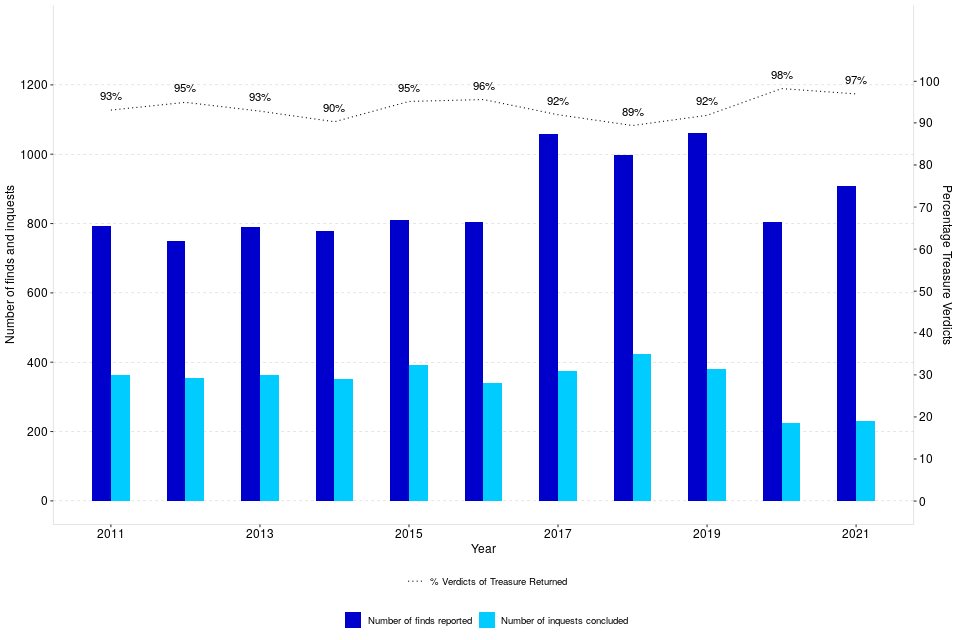
The number of finds and inquests held varies greatly across the country, most likely due to geographical and historical differences between areas. In 2021, 25 coroner areas had no treasure finds reported to them, whilst Norfolk had the highest number of treasure finds at 87. Map 4 shows treasure finds across England and Wales in 2021. More information about the duties of coroners to investigate treasure found within their jurisdiction and the provisions of the Treasure Act 1996 (and the previous Treasure Trove provisions) can be found in the supporting guidance.
Map 4: Number of treasure finds reported to coroners, England and Wales, 2021

13. Annex A: Details of recent Coroner Area amalgamations
The following table summarises the coroner area amalgamations that have occurred during 2020. There were no amalgamations in 2021. For a list of all historical amalgamations and changes to coroner areas, please refer to the supporting guidance document.
| Date effective | Previous Coroner Area | New Coroner Area | Nature of merge |
|---|---|---|---|
| 01-Apr-20 | Central Hampshire; North East Hampshire; Portsmouth and South East Hampshire; Southampton and New Forest | Hampshire, Portsmouth and Southampton | 4 into 1 |
14. Annex B: Further analysis of deaths reported to coroners
In 2021 the number of deaths reported to coroners as a proportion of registered deaths varied widely across coroner areas, from 16% in North Yorkshire (Western) to 82% in Newcastle upon Tyne
The number of deaths reported to coroners in 2021 varied markedly by coroner area – from 247 in City of London to 5,984 in Hampshire, Portsmouth and Southampton. The number of deaths reported in each area will be affected by its size, resident population, demographic breakdown and profile, so comparisons of deaths reported to coroners across coroner areas should be treated with caution.
When looking at the number of deaths reported to coroners in 2021 as a proportion of registered deaths[footnote 21], which allow for some differences in population characteristics, there is still a wide variation across coroner areas, with a minimum of 16% in North Yorkshire (Western) compared to the maximum of 82% in Newcastle upon Tyne. However, caution should be taken when using these figures as local area factors can influence these proportions. For example, large hospitals near boundary lines can impact the proportion, due to the difference between the coroners’ figures being based on the place of death and the ONS figures being based on the place of residence.
The rollout since April 2019 of non-statutory medical examiners who examine deaths not reported to coroners may explain a reduction in the number of deaths reported to coroners in some coroner areas.
Figure 10: Coroner areas split by the number of deaths reported to coroners in 2021 as a proportion of registered deaths (Source: Table 11)[footnote 22] [footnote 23]
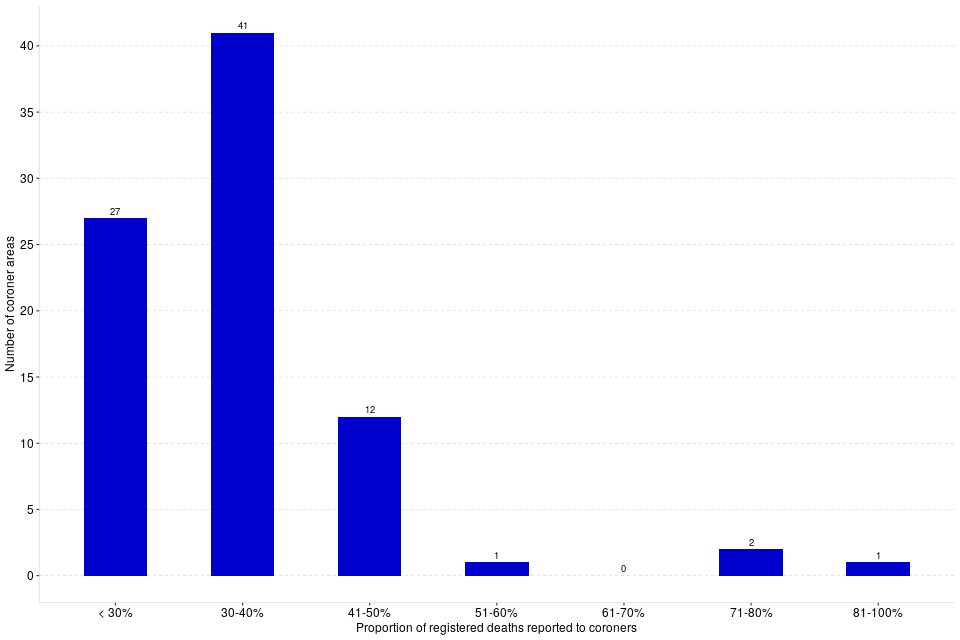
14.1 Further Information
Revisions to statistics for previous years
The estimated figure for the number of registered deaths in 2020 which was derived from monthly data for the purposes of Table 2 in last year’s edition of this bulletin has now been replaced by the annual figure published by the Office for National Statistics.
Symbols and rounding convention
Within the ‘Key Findings’ sections, figures greater than 1,000 are rounded to the nearest 100. The following symbols have been used throughout the tables in this bulletin:
| n/a | = | Not applicable |
| - | = | Zero |
| .. | = | No data available |
| (p) | = | Provisional Data |
| (r) | = | Revised Data |
Accompanying files
-
This bulletin should be read alongside the statistical tables which accompany it. These tables are also available in an accessible format.
-
There is also a supporting comma-separated values file (CSV) to allow users to carry out their own analysis.
-
In addition to the bulletin and tables, we have published a coroners’ statistical tool. The tool provides easier access to local level data and allows the user to compare up to four areas of interest, for example, it is possible to compare a coroner area with a geographical region, England and/or Wales.
-
The accompanying guide to coroner statistics provides a more detailed overview of coroners; including the functions of coroners and the chief coroner, policy background and changes, statistical revision policies, and data sources and quality. It also includes a glossary with brief definitions for some commonly used terms.
-
The quality statement published with this guide sets out our policies for producing quality statistical outputs for the information we provide to maintain our users’ understanding and trust.
National Statistics Status
National Statistics Status means that official statistics meet the highest standards of trustworthiness, quality and public value.
All official statistics should comply with all aspects of the Code of Practice for Official Statistics. They are awarded National Statistics status following an assessment by the Authority’s regulatory arm. The Authority considers whether the statistics meet the highest standards of Code compliance, including the value they add to public decisions and debate.
It is the Ministry of Justice’s responsibility to maintain compliance with the standards expected for National Statistics. If we become concerned about whether these statistics are still meeting the appropriate standards, we will discuss any concerns with the Authority promptly. National Statistics Status can be removed at any point when the highest standards are not maintained, and reinstated when standards are restored.
Contact
Press enquiries should be directed to the Ministry of Justice or HMCTS press office:
Sebastian Walters (MoJ) - email: Sebastian.Walters@justice.gov.uk
Other enquiries about these statistics should be directed to the Data and Evidence as a Service division of the Ministry of Justice:
Rita Kumi-Ampofo or Matteo Chiesa - email: CAJS@justice.gov.uk
Next update: Thursday 11th May 2023
URL: www.gov.uk/government/collections/coroners-and-burials-statistics
© Crown copyright
Produced by the Ministry of Justice
For any feedback on the layout or content of this publication or requests for alternative formats, please contact cajs@justice.gov.uk
-
1995 is the first year of annual data collection. ↩
-
Provisional figure based on ONS monthly death registration figures for 2021: https://www.ons.gov.uk/peoplepopulationandcommunity/birthsdeathsandmarriages/deaths/datasets/monthlyfiguresondeathsregisteredbyareaofusualresidence ↩
-
These data only represent deaths in custody which were referred to a coroner and subsequently reported to the Ministry of Justice in the coroner’s annual return. ↩
-
For further detail please see Figure 11 of ‘Monitoring the Mental Health Act in 2020/21’, available at the following link: https://www.cqc.org.uk/sites/default/files/20210127_mhareport_printer.pdf ↩
-
https://www.gov.uk/government/statistics/safety-in-custody-quarterly-update-to-december-2021 ↩
-
We have estimated the only less-invasive techniques figure for Hertfordshire due to inconsistency with the data supplied which could not be resolved. ↩
-
Schedule 1 to the Coroners and Justice Act 2009 states that the coroner should suspended an investigation in the event that criminal proceedings may or will take place. ↩
-
For years 2007-2013 this includes the previously used conclusions “Dependence on drugs” and “Non-dependent abuse on drugs” ↩
-
An analysis on unclassified conclusions can be found in the Coroners Statistics 2012 publication (Annex A), available at: www.gov.uk/government/statistics/coroners-statistics ↩
-
Total percentages may not equal 100% due to rounding ↩
-
‘All other conclusions’ includes: Killed lawfully; Killed unlawfully; Lack of care or self-neglect; Stillborn and represent together less than 1% of the short-form conclusions recorded. ↩
-
The sex of the deceased is based on the ‘registrable particulars’ which coroners have a duty to record. Deaths certificates only gives two options, ‘male’ and ‘female’, and these will normally be completed by the registrar based on the information given to them by the informant. Under normal circumstances there would not be an investigation to ascertain whether what the informant says corresponds to biological sex or DNA of the deceased. ↩
-
Lack of care or self-neglect was excluded from above, as there was only 35 such inquest conclusions in 2021. ↩
-
ONS data is available online at: www.ons.gov.uk/peoplepopulationandcommunity/birthsdeathsandmarriages/deaths/datasets/deathsregisteredinenglandandwalesseriesdrreferencetables ↩
-
The ‘age not known’ category has been excluded from the chart due to small numbers (less than 0.5%). Totals may not add up to 100% due to rounding. ↩
-
A direct average of the time taken to process an inquest cannot be calculated from the summary data collected; an estimate has therefore been made instead. Please see the Guide to the Coroners statistics published alongside this report for the methodology used. ↩
-
Only deaths occurring within England and Wales are included in this estimation. ↩
-
The Coroner Service: Government Response to the Committee’s First Report - Justice Committee - House of Commons (parliament.uk) ↩
-
The latest Department for Digital, Culture, Media & Sport (DCMS) figures are for 2020 and showed there were 1,077 finds reported in England and Wales, in line with the 803 treasure finds reported to Coroner Areas in 2020. These figures can be found at: https://www.gov.uk/government/statistics/statistical-release-for-reported-treasure-finds-2019-and-2020 ↩
-
This chart does not include reported findings under “Treasure Trove” ↩
-
As the ONS death registration figures are based on the area of usual residence whereas the coroners’ figures are based on the area where a person died, these figures should be used with caution. For example, the coroner office for the City of London shows a distorted figure above 100% due to the low level of residence and high level of commuters. ↩
-
Provisional figure based on ONS monthly death registration figures for 2021 ↩
-
City of London has been excluded from this analysis due to the percentage of deaths being greater than 100% - please see footnote 21 above for further information. So only 84 coroner areas have been included in this analysis. ↩
